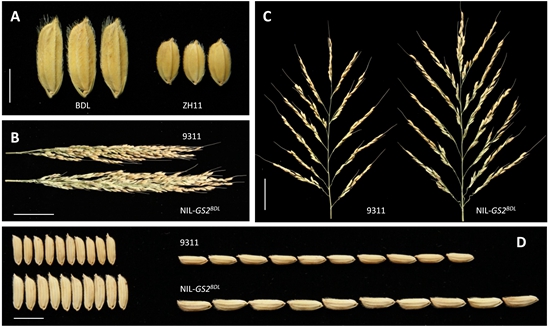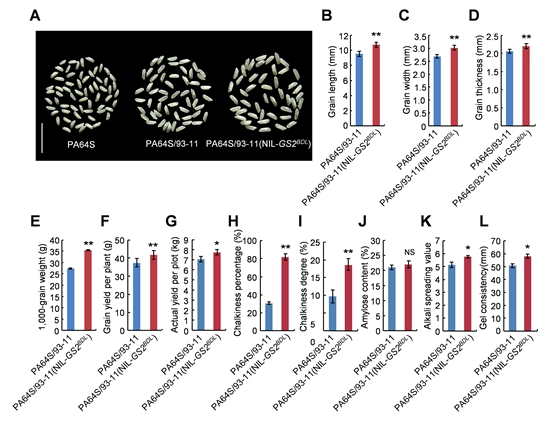分享到
Researchers reveal a dominant QTL to enhance rice grain size and grain yield
Grain size (length, width, and thickness) determines grain weight and affects grain quality. Several major quantitative trait loci (QTLs) regulating grain size have been cloned while our understanding of the underlying mechanism on size of rice grains regulation remains fragmentary. Recently, a study conducted by China National Rice Research Institute (CNRRI) of Chinese Academy of Agricultural Sciences (CAAS) found a dominant QTL (GS2) can lead to larger cells and increased numbers of cells, which thus enhances grain weight and yield.
To understand the molecular basis of grain size, CNRRI scientists identified a number of large-grain lines, including a full-and-large grain line, Baodali (BDL, Oryza sativa ssp. indica). Morphological observation revealed that both grain length and width were significantly increased in BDL as compared to Zhonghua 11 (ZH11, Oryza sativa ssp. japonica). By using molecular markers to carry out primary QTL analysis, six QTLs were identified, which might correlate with grain length, weight, or size in BDL. Among these QTLs, a major grain-size QTL, named GRAIN SIZE ON CHROMOSOME 2 (GS2) explained 72% of the phenotypic variation in grain length and 36% of the variation in grain width. The spikelet hulls and brown grains of the F1 plants were larger than those of ZH11, suggesting that GS2 is a dominant locus regulating grain size.

Figure 1. Phenotype and grain yield analysis of 9311 and 9311(NIL-GS2BDL)

To understand the molecular basis of grain size, CNRRI scientists identified a number of large-grain lines, including a full-and-large grain line, Baodali (BDL, Oryza sativa ssp. indica). Morphological observation revealed that both grain length and width were significantly increased in BDL as compared to Zhonghua 11 (ZH11, Oryza sativa ssp. japonica). By using molecular markers to carry out primary QTL analysis, six QTLs were identified, which might correlate with grain length, weight, or size in BDL. Among these QTLs, a major grain-size QTL, named GRAIN SIZE ON CHROMOSOME 2 (GS2) explained 72% of the phenotypic variation in grain length and 36% of the variation in grain width. The spikelet hulls and brown grains of the F1 plants were larger than those of ZH11, suggesting that GS2 is a dominant locus regulating grain size.

Figure 1. Phenotype and grain yield analysis of 9311 and 9311(NIL-GS2BDL)
With backcross population and map-based cloning strategy, CNRRI scientists cloned the gene and found it encodes a growth regulatory factor 4 in rice (OsGRF4). Further studies showed GS2 harbors a mutation in OsGRF4 that affects the target sequence of OsmiR396c, could elevate the expression of GS2 in rice and thus increase the grain size and panicle length, leading to enhanced grain yield. Scientists also introduced this dominant rare allele of GS2/OsGRF4 into super-hybrid variety Liang-you-pei-jiu (LYP9), and found it significantly enhanced grain weight and increased 9.5% grain yield, indicating the BDL allele of GS2 has great potential in efforts to breed high-yield, elite hybrid rice varieties.

Figure 2. Comparing traits between PA64S/9311 and PA64S/93-11(NIL-GS2BDL)
This work was supported by grants from Ministry of Science and Technology of China (2013 CBA01400) and National Natural Science Foundation of China (31221004, 31201004, 31201194 and 31271700).
The result finding has been published on Molecular Plant on July 14th 2015 (DOI: http://dx.doi.org/10.1016/j.molp.2015.07.002). More details are available on the links bellow:
http://www.cell.com/molecular-plant/abstract/S1674-2052(15)00296-8
The result finding has been published on Molecular Plant on July 14th 2015 (DOI: http://dx.doi.org/10.1016/j.molp.2015.07.002). More details are available on the links bellow:
http://www.cell.com/molecular-plant/abstract/S1674-2052(15)00296-8
Latest News
-
 Apr 18, 2024Opening Ceremony of the Training Workshop on Wheat Head Scab Resistance Breeding and Pest Control in Africa Held in CAAS
Apr 18, 2024Opening Ceremony of the Training Workshop on Wheat Head Scab Resistance Breeding and Pest Control in Africa Held in CAAS -
 Apr 03, 2024IPPCAAS Co-organized the Training Workshop on Management and Application of Biopesticides in Nepal
Apr 03, 2024IPPCAAS Co-organized the Training Workshop on Management and Application of Biopesticides in Nepal -
 Mar 28, 2024Delegation from the School of Agriculture and Food Science of University College Dublin, Ireland Visit to IAS, CAAS
Mar 28, 2024Delegation from the School of Agriculture and Food Science of University College Dublin, Ireland Visit to IAS, CAAS -
 Mar 25, 2024Director of World Food Prize Foundation visited GSCAAS
Mar 25, 2024Director of World Food Prize Foundation visited GSCAAS -
 Mar 20, 2024Institute of Crop Sciences (ICS) and Syngenta Group Global Seeds Advance Collaborative Research in the Seed Industry
Mar 20, 2024Institute of Crop Sciences (ICS) and Syngenta Group Global Seeds Advance Collaborative Research in the Seed Industry
